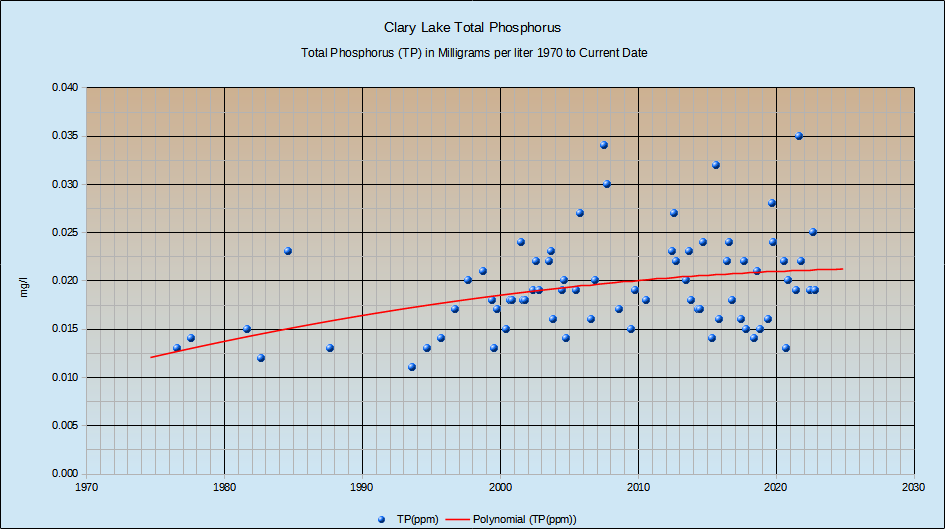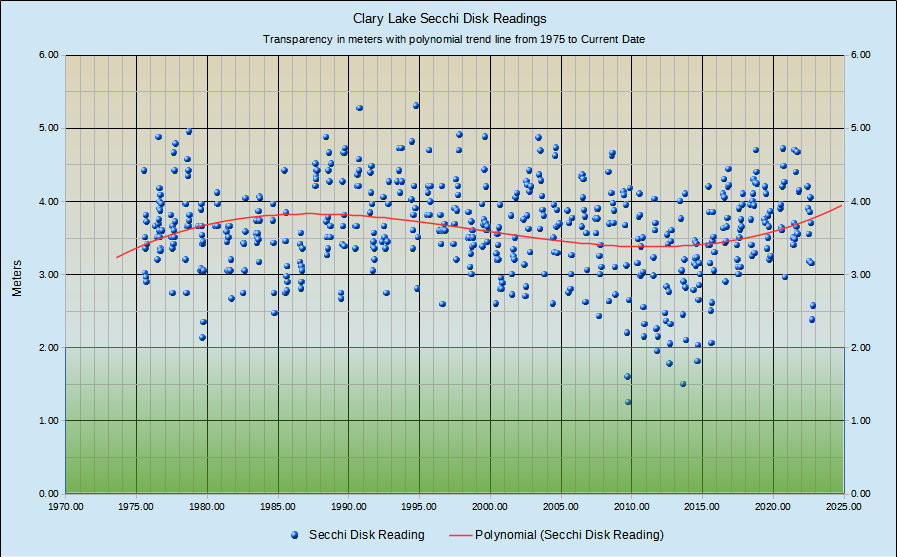The Total Phosphorus test results from our 8/6/2021 core water sample came back the other day at 0.035 mg/liter, the highest TP value we’ve ever recorded. This is ominous. The next highest value we recorded was 0.034 mg/liter in July 2007 (see chart at left). I don’t remember the particular circumstances surrounding that reading, but there was another high TP reading of 0.032 mg/l more recently, in July 2015 that I do remember. It coincided with a secchi disk reading of only 1.95 meters indicating an algae bloom was in progress (secchi disk readings of 2 meters and below indicate a bloom in progress). You can see this 1.95 meter data point on the chart showing Clary transparency below. In this particular case, extreme low water conditions were a major contributing factor to poor water quality!! I expected a high TP value this time because of the 9″ of rain received in July. Rain means runoff and runoff means soil erosion and sedimentation which is the primary source of Phosphorus in lakes, but still, I was surprised to see such a high number. High phosphorus levels are not good for water quality! We really need to update our Watershed Survey!
Despite the high phosphorus level, we haven’t seen a significant algae bloom yet this summer and we may not, though I did notice a few wisps of dead cyanobacteria along the shoreline back in August, and water transparency is currently holding up nicely: at our last the water monitoring session on Sunday September 5th, Kelsie French and I had secchi disk readings of 3.55 and 3.45 meters respectively which is about average, and better than expected considering the level of phosphorus in the water. Transparency could deteriorate quickly however and we’re going to keep a close eye on it; we will take our 3rd and final water sample for Phosphorus testing during our next water quality monitoring session in a couple of weeks. Continue reading






 The Annual Meeting of the Clary Lake Association that was held last Saturday, August 7th was a fine meeting, but not all that well attended. Much to our chagrin, it turns out we did not have a quorum present, something that didn’t become apparent until a couple of days later when I was reviewing the attendance records. Oops! This means that the election of Officers and Board members and the Membership approval of our 2021/2022 budget were invalid, and will have to be redone.
The Annual Meeting of the Clary Lake Association that was held last Saturday, August 7th was a fine meeting, but not all that well attended. Much to our chagrin, it turns out we did not have a quorum present, something that didn’t become apparent until a couple of days later when I was reviewing the attendance records. Oops! This means that the election of Officers and Board members and the Membership approval of our 2021/2022 budget were invalid, and will have to be redone. 












